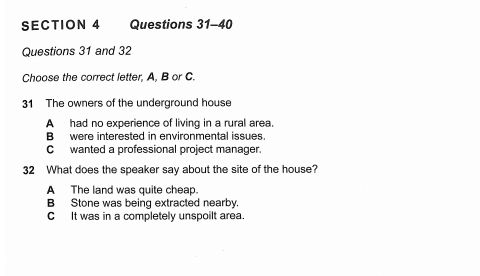剑桥雅思9听力:Test3雅思听力Section4解析
发布时间:2021-05-31 关键词:剑桥雅思9听力Section4
Good morning.
In the last few lectures I've been talking about the history of domestic building construction.
But today I want to begin looking at some contemporary, experimental designs for housing.
So, I'm going to start with a house which is constructed more or less under the ground.
And one of the interesting things about this project is that the owners - both professionals but not architects - wanted to be closely involved, so they decided to manage the project themselves.
Their chief aim was to create somewhere that was as environmentally-friendly as possible.
But at the same time they wanted to live somewhere peaceful — they'd both grown up in a rural area and disliked urban life.
So the first thing they did was to look for a site.
And they found a disused stone quarry in a beautiful area.
The price was relatively low, and they liked the idea of recycling the land, as it were.
As it was, the quarry was an ugly blot on the landscape, and it wasn't productive any longer, either.
They consulted various architects and looked at a number of designs before finally deciding on one.
As I've said, it was a design for a sort of underground house, and it was built into the earth itself, with two storeys.
The north, east and west sides were set in the earth, and only the sloping, south-facing side was exposed to light.
That was made of a double layer of very strong glass.
There were also photovoltaic tiles fixed to the top and bottom of this sloping wall.
These are tiles that are designed to store energy from the sun.
And the walls had a layer of foam around them too, to increase the insulation.
Now, what is of interest to us about this project is the features which make the building energy-efficient.
Sunlight floods in through the glass wall, and to maximise it there are lots of mirrors and windows inside the house.
That helps to spread the light around.
So that's the first thing - light is utilised as fully as possible.
In addition, the special tiles on the outside convert energy from the sun and generate some of the house's electricity.
In fact, and it’s possible that in future the house may even generatean electricity surplus, and that the owners will be able to sell some to the national grid.
As well as that, wherever possible, recycled materials have been used.
For example, the floors are made of reclaimed wood.
And the owners haven't bought a single item of new furniture - they just kept what they already had.
And then there's the system for dealing with the waste produced in the house.
This is dealt with organically - it's purified by being filtered through reed beds which have been planted for that purpose in the garden.
So the occupants of the house won't pollute the land or use any damaging chemicals.
It's true that the actual construction of the house was harmful to the environment, mainly because they had to use massive amounts of concrete - one of the biggest sources of carbon dioxide in manufacturing.
And as you know, this is very damaging to the environment.
In total, the house construction has released 70 tons of carbondioxide into the air.
Now that's a frightening thought.
However, once the initial 'debt' has been cleared - and it's been calculated that this will only take fifteen years - this underground house won't cost anything - environ mentally I mean - because unlike ordinary houses, it is run in a way that is completely environmentally friendly.
So, eco-housing like this is likely to become much more ...

Question 31
答案:B
定位原文:scripts: So, I'm going to start with a house, which is constructed more or less under the ground. And one of the interesting things about this project is that the owners, both professionals but not architects, wanted to be closely involved, so they decided to manage the project themselves.
解题思路:题干词 owner 在原文重现,方便定位。选项 C professional 一词出现时原文意为房屋的两位主人都是行业人士,并不是建筑师,与选项含义不符。后又马上提及 environmentally-friendly,与选项 B 相符。本题要求必须理解原文含义。
Question 32
答案:A
定位原文:scripts: So the first thing they did was to look for a site. And they found a disused stone quarry in a beautiful area. The price was relatively low, and they liked the idea of recycling the land, as it were.
解题思路:本题虽然没有出现明显的定位词,但主讲人提及 the price was relatively low (价格相对便宜),与选项 A 内容相符。其他选项未提及。
Question 33
答案:glass
定位原文:scripts: The north, east and west sides were set in the earth, and only the sloping, south-facing side was exposed to the light. That was made of a double layer of very strong glass.
解题思路:题干中小标题 design 帮助原文定位,south-facing side 进一步细节定位,答案处仅仅将题干词 two 替换为 double, 没有混淆信息。
Question 34
答案:insulation
定位原文:scripts: These are tiles that are designed to store energy from the sun. And the walls had a layer of foam around them too, to increase the insulation.
解题思路:本题可以用题干词 foam 进行定位,improve 和 increase 进行了互换,答案 insulation 一词平时使用的较少,可能存在拼写困难的情况。
Question 35
答案:windows
定位原文:scripts: Sunlight floods in through the glass wall, and to maximise it there are lots of mirrors and windows inside the house.
解题思路:本题需要注意 increase 与 maximise 的替换,原文与题干词汇相同。
Question 36
答案:electricity
定位原文:scripts: In addition, the special tiles on the outside convert energy from the sun and generate some of the house's electricity.
解题思路:本题题干词 in future 在原文重现,定位后需要反应 generate 和 produce 的替换、more 与 surplus 的替换。
Question 37
答案:floor/floors
定位原文:scripts: As well as that, wherever possible, recycled materials have been used. For example, the floors are made of reclaimed wood.
解题思路:本题词汇不难,需要进行主动与被动间的转换。题干词 wood 出现前答案已经出现。考查瞬间记忆能力。
Question 38
答案:waste
定位原文:scripts: And then there's the system for dealing with the waste produced in the house.
解题思路:本题难度相对较大。考查语言点有:主动与被动,process 与 deal with 的替换。但题干词 system 在原文答案前出现帮助定位,降低难度。
Question 39
答案:concrete
定位原文:scripts: It's true that the actual construction of the house was harmful to the environment, mainly because they had to use massive amounts of concrete- one of the biggest sources of carbon dioxide in manufacturing.
解题思路:本题在预测时可以判断需要名词,原文在题干词 construction quantity, harmful 等词出现后给出答案 concrete, 难度不大。但词汇可能对于部分考生来讲比较陌生,容易失分。
Question 40
答案:15 years
定位原文:scripts: However, once the initial 'debt' has been cleared, and it has been calculated that this will only take 15 years, this underground house won't cost anything- environmentally I mean- because unlike ordinary houses, it is run in a way that is completely environmentally friendly.
解题思路:本题在读题时较难预测需要捕捉什么成分。如果能够理解原文含义,本题不难解,但在无法理解时,会发现题干词 debt 在原文提及后所有涉及的信息只有 fifteen years。




